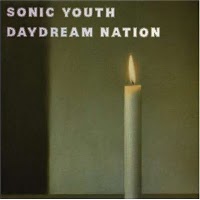 “Record collectors shouldn’t be in bands!” This is what Joe Carducci said when the other guys at SST records wanted to sign Sonic Youth in the mid eighties, And I can’t fully disagree with the statement. Sonic has spent their career as artsy NYC hipsters riding any and every genre of music that they may or may not have business making, as long as it’s “cool”. In the early days, it was mostly a band trying to balance with one foot in punk while holding on to their no wave and high art credibility. By the early nineties, they were consciously dumbing down to cash in on grunge riffs. But at some point between the two, they managed to create one of the best rock albums of all time, the massive double LP, Daydream Nation. It’s focused drive and sprawling experimentation come off so impressively natural. Somehow they balance a sort of psychedelic rock approach to slightly punk fueled pop songs with very DEAD C like noise drone outs that miraculously blend into a seamless late eighties indie record. Even the usually free flowing poetic vocals are at their least offensive. In fact most of the lyrics are amazing. It’s the band at their peak of maturity. The space inside each song seems to grow with each listen as well, which leads to what seems like endless repeated listenings. Sadly, the 4th side trails off into some annoying territory, but there’s so much to chew on already, and for the first three sides, nothing to skip. The sound suggests high art without the pretension overshadowing the human feel of the songs. Even Carducci later admitted that they were a good band in this period. That’s what I think impresses me the most about Sonic Youth; every instinct tells me that this band need’s to get real yet I always come back to them, and in Daydream’s case, rarely leave. –Alex
“Record collectors shouldn’t be in bands!” This is what Joe Carducci said when the other guys at SST records wanted to sign Sonic Youth in the mid eighties, And I can’t fully disagree with the statement. Sonic has spent their career as artsy NYC hipsters riding any and every genre of music that they may or may not have business making, as long as it’s “cool”. In the early days, it was mostly a band trying to balance with one foot in punk while holding on to their no wave and high art credibility. By the early nineties, they were consciously dumbing down to cash in on grunge riffs. But at some point between the two, they managed to create one of the best rock albums of all time, the massive double LP, Daydream Nation. It’s focused drive and sprawling experimentation come off so impressively natural. Somehow they balance a sort of psychedelic rock approach to slightly punk fueled pop songs with very DEAD C like noise drone outs that miraculously blend into a seamless late eighties indie record. Even the usually free flowing poetic vocals are at their least offensive. In fact most of the lyrics are amazing. It’s the band at their peak of maturity. The space inside each song seems to grow with each listen as well, which leads to what seems like endless repeated listenings. Sadly, the 4th side trails off into some annoying territory, but there’s so much to chew on already, and for the first three sides, nothing to skip. The sound suggests high art without the pretension overshadowing the human feel of the songs. Even Carducci later admitted that they were a good band in this period. That’s what I think impresses me the most about Sonic Youth; every instinct tells me that this band need’s to get real yet I always come back to them, and in Daydream’s case, rarely leave. –Alex
Rock
Uriah Heep “Demons and Wizards” (1972)
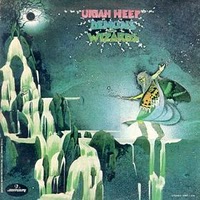 Uriah Heep’s 4th accentuates the pomp and bombast at the band’s core even further, “The Wizard” re-introducing us to the world of Demons and Wizards in grand, whisper to a scream style. Really, only two lively, pure of purpose rockers in this bunch, the good-timer “All My Life” and barreling “Easy Livin'” (the band’s first US top 40 entry). It’s imposing works of sorcery and heft like “Traveller in Time,” the hard swing of “Poet’s Justice,” which sounds in places like Scott Walker gone heavy (really!) and “Circle of Hands,” a majestic number recalling Zep’s “Thank You,” that one carries into the unquiet slumbers experienced after too many hours steeped in the Heep. Elsewhere, “Rainbow Demon” chains you to a Hyborian Wheel of Pain with it’s leaden, Iommi on organ riff, as Demons concludes with the meandering “Paradise/The Spell,” an alternately lush and rollicking soar towards the heavens. –Rob
Uriah Heep’s 4th accentuates the pomp and bombast at the band’s core even further, “The Wizard” re-introducing us to the world of Demons and Wizards in grand, whisper to a scream style. Really, only two lively, pure of purpose rockers in this bunch, the good-timer “All My Life” and barreling “Easy Livin'” (the band’s first US top 40 entry). It’s imposing works of sorcery and heft like “Traveller in Time,” the hard swing of “Poet’s Justice,” which sounds in places like Scott Walker gone heavy (really!) and “Circle of Hands,” a majestic number recalling Zep’s “Thank You,” that one carries into the unquiet slumbers experienced after too many hours steeped in the Heep. Elsewhere, “Rainbow Demon” chains you to a Hyborian Wheel of Pain with it’s leaden, Iommi on organ riff, as Demons concludes with the meandering “Paradise/The Spell,” an alternately lush and rollicking soar towards the heavens. –Rob
Frank Zappa “Freak Out!” (1966)
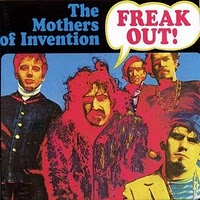 This is a true album for freaks. Back in 1967, Zappa must have felt left out of the hippy dippy counterculture because his musical interests seemed to extend beyond flowers in your hair, acoustic guitars and sitting barefoot in the park. So with this debut he in turn created a counterculture to the counterculture – an album for all the freaks and “left behinds” as he refers to them in the opening track Hungry Freaks Daddy. The music is frequently upbeat, jazzy and conventional, at least by Zappa’s standards. He had not yet started his long guitar explorations of later albums, and the only real “surreal” tracks are Who Are The Brain Police?, Help I’m A Rock, and the truly whacked out closer The Return Of The Son Of Monster Magnet. It’s these more experimental tracks that most intrigue me just in their sheer ludicrousness. They all sound like drug induced paranoia with their screaming, sound effects and seemingly made up language. –Neal
This is a true album for freaks. Back in 1967, Zappa must have felt left out of the hippy dippy counterculture because his musical interests seemed to extend beyond flowers in your hair, acoustic guitars and sitting barefoot in the park. So with this debut he in turn created a counterculture to the counterculture – an album for all the freaks and “left behinds” as he refers to them in the opening track Hungry Freaks Daddy. The music is frequently upbeat, jazzy and conventional, at least by Zappa’s standards. He had not yet started his long guitar explorations of later albums, and the only real “surreal” tracks are Who Are The Brain Police?, Help I’m A Rock, and the truly whacked out closer The Return Of The Son Of Monster Magnet. It’s these more experimental tracks that most intrigue me just in their sheer ludicrousness. They all sound like drug induced paranoia with their screaming, sound effects and seemingly made up language. –Neal
Caravan “In the Land of Grey and Pink” (1971)
Caravan turned in a classic with 1971’s “In the Land of Grey and Pink,” with their insistent grooves, tongue-in-cheek lyrics with a uniquely English bent, and Richard Sinclair’s expansive, jazzy organ solos, this album largely set the template for the Canterbury sound. Caravan’s penchant for a whimsical, nodding bounce combined with a strong melodic hook is featured on “Golf Girl,” “Love to Love You (And Tonight Pigs Will Fly),” and the driving title track and reaches a peak on “Winter Wine,” as the band turns in a darker hued, intricate track featuring fantasy imagery. “Winter Wine” foreshadows the album’s pièce de résistance, “Nine Feet Underground,” a meandering multi-part suite that features some killer instrumental excursions coupled with some of the album’s most ingratiating melodies. –Ben
Prefab Sprout “Steve McQueen” (1985)
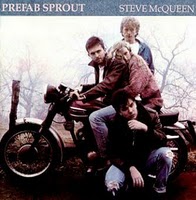 Saying Steve McQueen is easy listening, is like saying Twin Peaks was a soap opera. At first glance both statements seem true, yet both works have a way of distorting such unattractive mediums so much that it becomes something so different that could never be replicated again. Now Steven McQueen doesn’t have scary synths or a lady carrying logs narrating, so I’m going to kill that comparison now. Song by song, I have heard very few albums that measure up as well as Prefab Sprout’s crowning achievement. Listening over and over (sometimes five times in a row), I just start picking out individual moments in a song that add so much more charm and mystery to the bigger picture. Paddy McAloon has one of the best vocals in music, and just had the essence of someone you want to follow or know about simply through the power of his performance. Every song on here comes so close to the line between heartbreak and recovery, that they all capture the essence of both and never fail to move me. It’s something truly special and one of the greatest albums ever. Like at the end of The Great Escape when Steven McQueen is out running the germans on his motorcycle. He sadly flips out and ends up where he began, back in the camp. He didn’t succeed but he’s happy. Why? Because he’s Steve McQueen and that’s a bad mother fucker. –Allistair
Saying Steve McQueen is easy listening, is like saying Twin Peaks was a soap opera. At first glance both statements seem true, yet both works have a way of distorting such unattractive mediums so much that it becomes something so different that could never be replicated again. Now Steven McQueen doesn’t have scary synths or a lady carrying logs narrating, so I’m going to kill that comparison now. Song by song, I have heard very few albums that measure up as well as Prefab Sprout’s crowning achievement. Listening over and over (sometimes five times in a row), I just start picking out individual moments in a song that add so much more charm and mystery to the bigger picture. Paddy McAloon has one of the best vocals in music, and just had the essence of someone you want to follow or know about simply through the power of his performance. Every song on here comes so close to the line between heartbreak and recovery, that they all capture the essence of both and never fail to move me. It’s something truly special and one of the greatest albums ever. Like at the end of The Great Escape when Steven McQueen is out running the germans on his motorcycle. He sadly flips out and ends up where he began, back in the camp. He didn’t succeed but he’s happy. Why? Because he’s Steve McQueen and that’s a bad mother fucker. –Allistair
Nektar “Down to Earth” (1974)
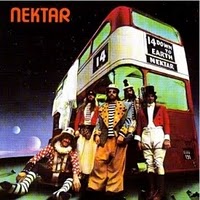 Temporarily abandoning the extended suite forms of their previous releases, Nektar turn in an accessible, almost pop-flavored collection of shorter songs with Down To Earth. Although it orbits in a sort of Euro-hippie galaxy, and features a vague circus concept running throughout, don’t let that scare you away, as this is a focused album with consistently strong songs. My favorites include the giant-sized “Nelly The Elephant,” (which sounds more than a little like part of Pink Floyd’s “Echoes”), animated “That’s Life,” expressive ballad “Little Boy,” and insistent “Show Me The Way,” but even the lesser stuff is pretty great. A refreshing, successful departure from the norm for Nektar. –Ben
Temporarily abandoning the extended suite forms of their previous releases, Nektar turn in an accessible, almost pop-flavored collection of shorter songs with Down To Earth. Although it orbits in a sort of Euro-hippie galaxy, and features a vague circus concept running throughout, don’t let that scare you away, as this is a focused album with consistently strong songs. My favorites include the giant-sized “Nelly The Elephant,” (which sounds more than a little like part of Pink Floyd’s “Echoes”), animated “That’s Life,” expressive ballad “Little Boy,” and insistent “Show Me The Way,” but even the lesser stuff is pretty great. A refreshing, successful departure from the norm for Nektar. –Ben
Queen “Queen II” (1974)
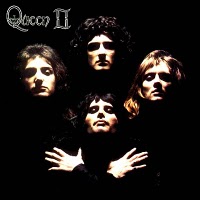 It’s a slightly awkward (and goofy) amalgam of Glam and Prog and Metal, but only slightly: the band catches fire and forges the core of their classic sound (in which Glam and Prog and Metal get along Famously) with this second release, a dense, majestic, and, of course, operatic sequence that inhabits a dark sound-world while delivering shimmering pop hooks aplenty. Gallivanting sword ’n’ sorcery themes alternate with classic r ’n’ r rebellion, and somehow it all works, even if I get the feeling that they could’ve developed some of these songs a little more. Incidentally, this also can be cited, for better or worse, as the origin of Smashing Pumpkins’ whole guitar sound and song dynamic (not to mention melodic sensibility) on their (his) early records—so fans of that stuff should look this up. Low on hits but stacked with impressive “deep cuts,” this is to my ears nearly as good as successors Sheer Heart Attack and A Night at the Opera; in fact, I find that I play this one more often than either—if only to hear tracks that never fail to surprise me in this album’s baffling yet strangely fluent sequencing (“White Queen,” “Some Day One Day,” and the Phil Spectral “Funny How Love Is”). –Will
It’s a slightly awkward (and goofy) amalgam of Glam and Prog and Metal, but only slightly: the band catches fire and forges the core of their classic sound (in which Glam and Prog and Metal get along Famously) with this second release, a dense, majestic, and, of course, operatic sequence that inhabits a dark sound-world while delivering shimmering pop hooks aplenty. Gallivanting sword ’n’ sorcery themes alternate with classic r ’n’ r rebellion, and somehow it all works, even if I get the feeling that they could’ve developed some of these songs a little more. Incidentally, this also can be cited, for better or worse, as the origin of Smashing Pumpkins’ whole guitar sound and song dynamic (not to mention melodic sensibility) on their (his) early records—so fans of that stuff should look this up. Low on hits but stacked with impressive “deep cuts,” this is to my ears nearly as good as successors Sheer Heart Attack and A Night at the Opera; in fact, I find that I play this one more often than either—if only to hear tracks that never fail to surprise me in this album’s baffling yet strangely fluent sequencing (“White Queen,” “Some Day One Day,” and the Phil Spectral “Funny How Love Is”). –Will
The Kinks “Arthur or the Decline and Fall of the British Empire” (1969)
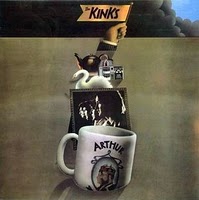 The freshness of a piece like “Shangri-La” is astonishing. It’s as relevant to middle-class values today as it was 40 years ago. “Brainwashed” continues the examination, which is completed by “Nothing To Say” taking a look from a completely different perspective. Brilliant! Individually most of the songs aren’t great. The exceptions are the brilliant “Victoria”, “Shangri-La” and “Young And Innocent Days”. But, put together the songs amount to another masterpiece from the Kinks. I don’t know of another lyricist who has achieved on one album of popular music what Ray Davies has achieved here – a complete social history of a particular era. –Jim
The freshness of a piece like “Shangri-La” is astonishing. It’s as relevant to middle-class values today as it was 40 years ago. “Brainwashed” continues the examination, which is completed by “Nothing To Say” taking a look from a completely different perspective. Brilliant! Individually most of the songs aren’t great. The exceptions are the brilliant “Victoria”, “Shangri-La” and “Young And Innocent Days”. But, put together the songs amount to another masterpiece from the Kinks. I don’t know of another lyricist who has achieved on one album of popular music what Ray Davies has achieved here – a complete social history of a particular era. –Jim
Van Morrison “Common One” (1980)
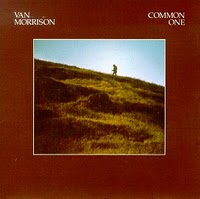 If not the least accessible and popular Van album, it is definitely one of them. Having two songs that both go over fifteen minutes, being made in a week, and carrying a very experimental jazz vibe it sounds unique in Van’s catalog.
If not the least accessible and popular Van album, it is definitely one of them. Having two songs that both go over fifteen minutes, being made in a week, and carrying a very experimental jazz vibe it sounds unique in Van’s catalog.
“Summertime in England” builds and builds up until it’s majestic ending blows the house down, “When the Heart is Open” is the most ambient song of his career and is the best song to fall asleep to on a rainy day. The other four songs are equally great. The album only feels more organic and beautiful put into the context of the time. It was a celebration of spirit and freedom [released in 1980]. –Allistair
Spinal Tap “This Is Spinal Tap” (1984)
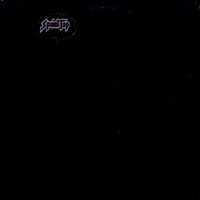 The soundtrack to Spinal Tap’s cult rockumentary serves as the only easy place to hear highlights from long out of print, impossible to find albums like Brainhammer, Shark Sandwich, and Bent For The Rent, with classics like the onstage anthem “Tonight I’m Gonna Rock You,” the squalid “Hell Hole,” and sexual throb of “Big Bottom” and #5 Japanese hit “Sex Farm” leading the charge. Tap’s regrettable flirtations with progressive rock are represented by “Stonehenge,” and the ill-timed ’77 release “Rock And Roll Creation,” the album also featuring the previously unreleased Tufnel composition, “America,” and both sides of the band’s pre-Tap Thamesmen 7-inch, “Gimmie Some Money/Cups and Cakes,” both fine examples of the so called “Squatneybeat” sound that gripped the UK for 3 days in 1965. Until the long promised Tap reissues arrive (“A lot of our music they won’t put out on CD because it’s too vibrant.” – David St. Hubbins), This Is Spinal Tap is your best bet for a taste of the Tap. –Ben
The soundtrack to Spinal Tap’s cult rockumentary serves as the only easy place to hear highlights from long out of print, impossible to find albums like Brainhammer, Shark Sandwich, and Bent For The Rent, with classics like the onstage anthem “Tonight I’m Gonna Rock You,” the squalid “Hell Hole,” and sexual throb of “Big Bottom” and #5 Japanese hit “Sex Farm” leading the charge. Tap’s regrettable flirtations with progressive rock are represented by “Stonehenge,” and the ill-timed ’77 release “Rock And Roll Creation,” the album also featuring the previously unreleased Tufnel composition, “America,” and both sides of the band’s pre-Tap Thamesmen 7-inch, “Gimmie Some Money/Cups and Cakes,” both fine examples of the so called “Squatneybeat” sound that gripped the UK for 3 days in 1965. Until the long promised Tap reissues arrive (“A lot of our music they won’t put out on CD because it’s too vibrant.” – David St. Hubbins), This Is Spinal Tap is your best bet for a taste of the Tap. –Ben
Nick Drake “Bryter Layter” (1970)
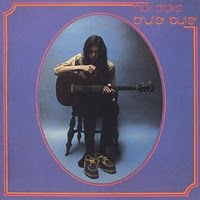 Five Leaves Left was Drake balancing on a wire as lush orchestras complimented bare acoustics with songs that cried in the evening and smiled in the morning. While Pink Moon can be seen as Drake dialed down to -1, Bryter Lyter is Drake turned up to 11. You can hear his smile when he sings on “Hazy Jane II” and you can feel the tears roll on (“Northern Sky”). While the strings on “River Man” and “Cello Song” off his debut added a dramatic flair, the arrangements here added a steady backbone and call for celebration. While the integrity behind the change in sound isn’t that inspiring, the execution is. Who would have known that John Cale of all people who bring the crowning moment of the album when he plays the piano solo in “Northern Sky”? –Allistair
Five Leaves Left was Drake balancing on a wire as lush orchestras complimented bare acoustics with songs that cried in the evening and smiled in the morning. While Pink Moon can be seen as Drake dialed down to -1, Bryter Lyter is Drake turned up to 11. You can hear his smile when he sings on “Hazy Jane II” and you can feel the tears roll on (“Northern Sky”). While the strings on “River Man” and “Cello Song” off his debut added a dramatic flair, the arrangements here added a steady backbone and call for celebration. While the integrity behind the change in sound isn’t that inspiring, the execution is. Who would have known that John Cale of all people who bring the crowning moment of the album when he plays the piano solo in “Northern Sky”? –Allistair
Lucifer’s Friend “Lucifer’s Friend” (1970)
 This German hard rock machine, with British belter John Lawton, (later of Uriah Heep) gave birth to one of the best heavy rock albums of the early 70’s. From the screaming vocals of “Ride In The Sky” (with its brass opening reminiscent of Zeppelin’s “The Immigrant Song” and an almost “thrash metal” riff) to the progressive/hard R&B of “Toxic Shadows”, to the lumbering, Sabbathish doom of “Keep Goin”, this album never lets up for a second. Fans of Black Sabbath, Uriah Heep, Deep Purple and Led Zeppelin must have this in their collection! Lawton is one of the best singers in hard rock, and the musicianship of the group is tremendous. Very heavy indeed for a 1971 release. The bonus tracks show the more mainstream, rock ‘n’ rollin’ side of the band, but the instrumentals “Horla” and “Satyr’s Dance” (taken from B-sides) really cook. Do yourself a large favor and check this one out. —Chris
This German hard rock machine, with British belter John Lawton, (later of Uriah Heep) gave birth to one of the best heavy rock albums of the early 70’s. From the screaming vocals of “Ride In The Sky” (with its brass opening reminiscent of Zeppelin’s “The Immigrant Song” and an almost “thrash metal” riff) to the progressive/hard R&B of “Toxic Shadows”, to the lumbering, Sabbathish doom of “Keep Goin”, this album never lets up for a second. Fans of Black Sabbath, Uriah Heep, Deep Purple and Led Zeppelin must have this in their collection! Lawton is one of the best singers in hard rock, and the musicianship of the group is tremendous. Very heavy indeed for a 1971 release. The bonus tracks show the more mainstream, rock ‘n’ rollin’ side of the band, but the instrumentals “Horla” and “Satyr’s Dance” (taken from B-sides) really cook. Do yourself a large favor and check this one out. —Chris


